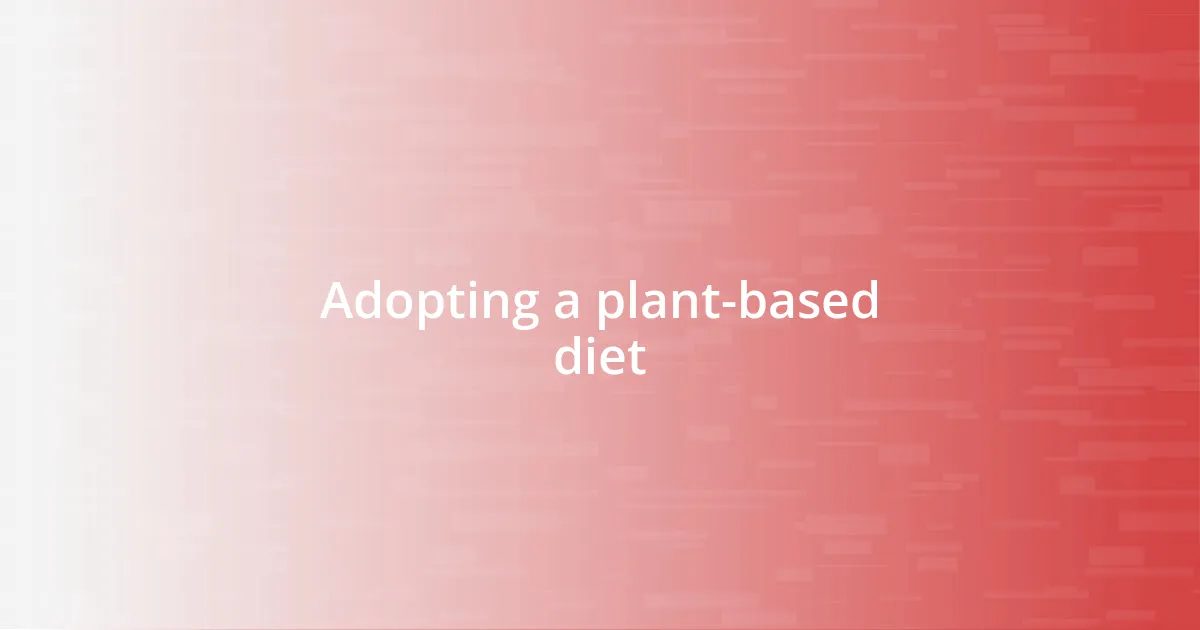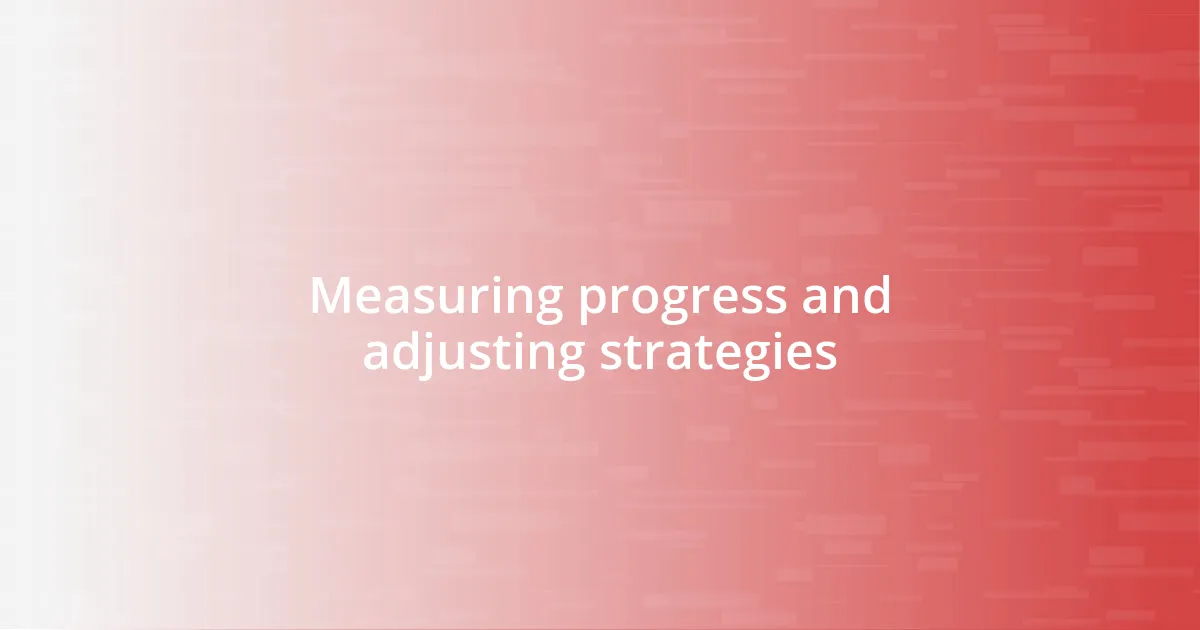Key takeaways:
- Understanding carbon footprint requires awareness of how individual choices in energy, transportation, and food impact greenhouse gas emissions.
- Setting SMART goals for reducing emissions, such as biking to work and minimizing waste, helps transform intentions into actionable steps.
- Adopting sustainable transportation methods, like biking and public transit, not only reduces carbon output but also enhances personal well-being and connections with others.
- Regularly measuring progress and adjusting strategies fosters continuous improvement and deeper commitment to sustainability.

Understanding carbon footprint
Understanding carbon footprint involves grasping the total greenhouse gas emissions directly and indirectly associated with an individual’s lifestyle. It’s more than just a number; it reflects my choices in energy, transportation, and even the food I consume. If you’ve ever wondered how your daily habits impact the planet, you’re not alone. I certainly had my “aha” moment when I realized that even small daily decisions could add up to a significant footprint.
When I first started tracking my carbon footprint, it felt overwhelming. I remember calculating the emissions from my car trips and feeling a knot in my stomach. The data revealed how my routine commuting was contributing far more to climate change than I had anticipated. It’s a stark reminder: have you ever considered how many trips you take without a second thought about their impact? Discovering that my choices were costing the planet made me rethink my transportation habits.
Every product I buy has a carbon footprint, and understanding this concept changed my shopping habits dramatically. For instance, transitioning to a plant-based diet made a noticeable difference—I felt lighter in more ways than one! Asking myself, “Where does this food come from, and how did it get here?” became part of my routine. It was enlightening to see how even the simplest changes could enrich my life while reducing my environmental impact. Isn’t it fascinating to think about how our daily actions collectively shape the future?

Identifying key sources of emissions
Identifying key sources of emissions often begins with a personal inventory of your daily activities. For me, it was eye-opening to keep a journal of my habits. Initially, I was shocked to discover how much my home energy use contributed, especially during the winter months. I never thought those cozy nights cozied up with the heater running could cost so much, both financially and environmentally. Have you ever considered the impact of your heating choices on your carbon footprint?
Another major source of emissions stemmed from my dining decisions. After noticing the carbon footprint of meat compared to plant-based foods, I felt compelled to shift my meals. I remember the day I decided to try a meatless Monday; it was a small step that transformed my entire week. Reflecting on how our food choices matter—it’s not just about personal health; it’s about the planet. Have you ever thought about what’s on your plate and how it ties back to your carbon footprint?
Transportation also played a crucial role in my carbon output. I used to drive everywhere, often without thinking about alternative options. Switching to biking for short trips drastically reduced my emissions and didn’t just benefit the environment—it made me fitter too! It’s funny how one decision can lead to a cascade of positive changes. How often do you consider your commute? Each mode of transport comes with its own set of emissions that can really add up.
| Source of Emissions | Personal Impact |
|---|---|
| Home Energy Use | Increased awareness of energy conservation |
| Food Choices | Transitioned to a more plant-based diet |
| Transportation | Switched to biking for shorter trips |

Setting specific reduction goals
Setting concrete reduction goals was pivotal in my journey to lower my carbon footprint. I remember when I first set my sights on making real changes; it felt daunting. I decided to make my goals SMART—specific, measurable, achievable, relevant, and time-bound. For example, instead of just saying “I’ll drive less,” I aimed for “I will bike to work once a week for the next month.” This clarity made my intentions more tangible and doable.
Here are some goals I found particularly effective:
- Limit car use: Commit to using public transit or biking for at least two trips a week.
- Reduce energy consumption: Aim to lower electricity use by 15% within six months by turning off lights and unplugging devices.
- Eat more plant-based meals: Incorporate at least one meatless day into my weekly meal plan to explore new recipes.
- Minimize waste: Reduce single-use plastic by switching to reusable bags and containers within a month.
Each of these targets not only structured my efforts but also infused my daily life with purpose. The sense of accomplishment that came from hitting these milestones was intoxicating. It ignited a deeper commitment to my sustainable journey, proving that setting specific goals truly transforms intention into action.

Implementing sustainable transportation choices
Once I recognized the heavy toll of my daily driving, I knew changes were necessary. I adopted a bike-sharing program offered in my city. The thrill I felt gliding through the streets on two wheels, wind in my hair, was liberating. Have you ever felt that rush of freedom while riding? Not only did I reduce my carbon footprint, but I also loved discovering my neighborhood in a way I never had before.
Public transit emerged as another sustainable choice I embraced. Initially, I was hesitant, imagining the potential hassles. But when I finally tried the bus, I found unexpected pleasures—reading a book undisturbed while someone else navigated traffic brought me peace. It’s incredible how stepping away from the driver’s seat can give you time to unwind. Have you thought about the hidden joys of using public transport?
Carpooling also became a part of my routine. When a colleague suggested sharing rides to work, I didn’t realize how transformative it would be. Not only did it cut emissions in half, but it sprouted friendships and enriched my workday with camaraderie. I often wonder, could combining trips with others be the secret ingredient for a more sustainable lifestyle? It feels so rewarding to know you’re not just lightening your load but also sharing those moments with others who crave a greener path.

Reducing energy consumption at home
Reducing energy consumption at home has been one of the most impactful changes I made in my journey. I started by swapping out traditional light bulbs for LEDs. It was a simple switch, but seeing my electricity bill drop made me feel like I was making a real difference. Have you ever noticed how small changes can yield surprising results?
Next, I established a habit of unplugging appliances when they weren’t in use. Initially, it felt like an inconvenience, but soon it became second nature. One day, as I stood in my kitchen, unplugging my coffee maker after brewing, I realized just how much energy we leave on the table—literally. The satisfaction of knowing I’m cutting down on “phantom energy” fueled my dedication.
In addition to those efforts, I began monitoring my heating and cooling usage more closely. I invested in a programmable thermostat, which allowed me to set temperature variations based on my schedule. The first time I returned home to a comfortably warm house without having to keep the heat cranked up all day was a revelation. It made me think: How many of us could reclaim savings with just a bit of planning? The beauty of reducing energy consumption lies in its simplicity and the immediate impact we can have on our environment.

Adopting a plant-based diet
Transitioning to a plant-based diet was one of my most rewarding experiences. It all started with a single Meatless Monday—just an experiment to see how I felt. I remember sitting down to a vibrant plate of quinoa, black beans, and roasted vegetables. To my delight, not only did I feel lighter and more energetic, but I also took a moment to realize how delicious and fulfilling plant-based meals could be. Have you ever thought about how one small change could make a big impact on your health and the planet?
As I delved deeper, I discovered this vast world of flavors and textures I’d been missing. Trying new recipes became my afternoon delight. One day, I found myself hybridizing a lentil bolognese that wowed my friends during dinner parties. The astonishment in their eyes as they swirled pasta with the sauce told me I was onto something. Isn’t it fascinating how food can bring people together, especially when it’s healthy and cruelty-free?
Of course, I faced some challenges along the way. Social gatherings occasionally turned into moments of anxiety as I navigated menus filled with steak and seafood. But then I realized that I could advocate for my lifestyle. I began suggesting restaurants that offered plant-based options, and to my surprise, many friends embraced trying out these cuisines with me. It turned into a shared adventure! Isn’t it incredible to think how a few plant-based meals could inspire those around us? It feels empowering knowing my choices can encourage others toward a more sustainable future.

Measuring progress and adjusting strategies
Tracking my progress in reducing my carbon footprint has been both eye-opening and rewarding. I started journaling my initiatives, noting down the energy usage before and after making changes. The moment I compared the data, I felt a sense of accomplishment wash over me. Have you ever experienced the thrill of seeing tangible proof of your efforts? It motivates you to push further.
Adjusting my strategies along the way became essential as I learned what worked and what didn’t. For instance, after a month of biking to work, I noticed how energizing it was but also realized I needed a backup plan for rainy days. That led me to carpool with a colleague, which not only reduced my footprint but also fostered a new friendship. Have you thought about the unexpected benefits that come with making sustainable choices?
Reflecting on my journey helped me identify areas for improvement. I began conducting monthly reviews to assess my habits—be it food waste or transportation choices. One evening, while planning my grocery list, I had an epiphany about meal prepping to combat food waste. Have you ever tried it? The process not only made my meals more efficient but also cut down on impulsive buys. It’s in these adjustments that I found continuous growth and deeper investment in my commitment to sustainability.












